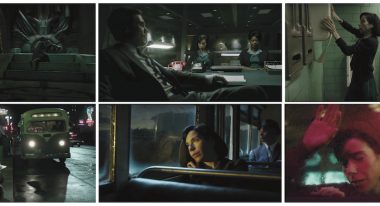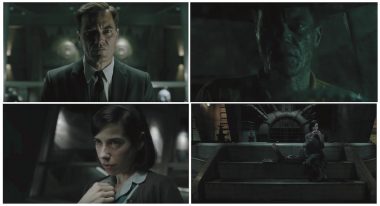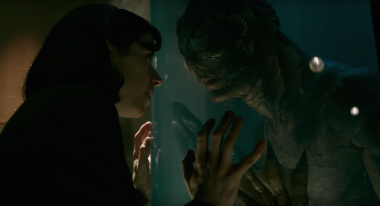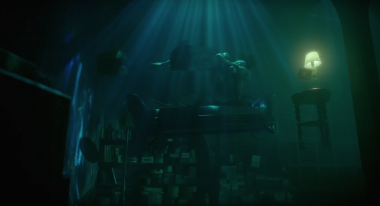 Back to selection
Back to selection
Shutter Angles
Conversations with DPs, directors and below-the-line crew by Matt Mulcahey
DP Dan Laustsen on The Shape of Water, Judging Exposure without a Meter and Capturing Rich Blacks
 Sally Hawkins and Doug Jones in The Shape of Water
Sally Hawkins and Doug Jones in The Shape of Water There’s a line in Bob Dylan’s “Brownsville Girl” that goes, “(It’s) strange how people who suffer together have stronger connections than people who are most content.” Suffering together connected director Guillermo del Toro and cinematographer Dan Laustsen on the set of 1997’s Mimic. The Miramax-produced giant insect creature feature marked the first American effort for del Toro and just the second studio gig for the Danish Laustsen. The experience was not a pleasant one. As del Toro put it during an on-stage interview at the BFI London Film Festival last October: “Two horrible things happened in the late ’90s: my father was kidnapped and I worked with the Weinsteins.”
Nearly two decades passed before del Toro and Laustsen saw each other again. They occasionally spoke on the phone – del Toro would call Laustsen for crew recommendations when he was shooting in Eastern Europe. “Then one day Guillermo called me and said, “Come to Toronto and shoot Crimson Peak,” recalls Laustsen. “When I met him in Toronto it was like we were just together two days ago.”
It was on the set of Crimson Peak that del Toro first described to Laustsen his vision for The Shape of Water – a 1960s-set story about a mute cleaning woman (Sally Hawkins) who saves an amphibious creature (Doug Jones) from a secret government research facility. With the film now out in wide release, Laustsen – whose credits include John Wick: Chapter 2 and my favorite French martial arts/werewolf period film, Brotherhood of the Wolf – spoke to Filmmaker about shooting dry-for-wet, judging exposure and capturing Shape’s rich blacks.
Filmmaker: Did Guillermo ever tell you what made him think of you again for Crimson Peak? Did he see something you had shot recently?
Laustsen: I never asked him, so I have no idea, but we have so much fun working together. He’s a fantastic director. He just loves to be on set and everybody loves to be around him because he’s so precise. He knows exactly where he wants to go and we just have to figure out how to get there.
Filmmaker: You can see that precision in the way color is used in The Shape of Water. The film’s palette is dominated by green and blue, but then warm light and the color red are used for specific effect. Some of that palette is the byproduct of the color of the sets and costumes. How do you go about achieving those colors on your end of things?
Laustsen: That steel blue color we used for The Shape of Water goes all the way back to something we used on Mimic. When I have those steel blue and green colors, I’m always at 3200° Kelvin on the lights and 3200° Kelvin on the camera as well. Then I’ll use gel on the lights to get the exact color I want. Guillermo and I like to shoot at a 1-to-1 ratio, meaning that our dailies look more or less like the final movie is going to look. In the Digital Intermediate (DI) we’ll use some power windows for adjustments, but the overall color is very close to what we shot.
Filmmaker: There are a lot of options now for film lights that allow you to dial in specific colors on the unit rather than using gels. But you still prefer the gels?
Laustsen: This was a pretty small movie – it’s a $19.5 million budget – so I had to be clever about our budget for lighting and camera. We couldn’t afford to have a bunch of Arri SkyPanels on set. When you have to move so fast, I think it’s easier to control the light the old fashioned way — use 3200° Kelvin lights and then put the gels on for the color. It’s a little bit backwards, but it worked for me on this movie.
I did use a lot of LED lighting for key lights, but I would gel them rather than dialing in the color on the heads. If I wanted Steel Blue, I put Steel Blue gel on. If I wanted CTO, I put some CTO on. However, I do like the flexibility of being able to change [the brightness] of the LEDs, so we were always adjusting them maybe five points up or five points down. So I’m using the LEDs to change the exposure, but not to change the color.
Filmmaker: You try to get the colors you want on set, but how about your black levels? This movie has beautifully rich blacks. Do you also try to get that on set or do you drag down your blacks a bit in the DI?
Laustsen: We did pull the blacks down a little bit, but the key to getting those rich blacks is that I never used fill light. I only used key light and negative fill. And I always shot between a T2.8 and a T4. I’d say 95 percent of the movie was shot between those two stops because all of the “dirty light,” this ambient light (that spills onto the set), disappears into the shadows when you shoot around a T3.5. That’s exactly the same thing we did on Crimson Peak. Guillermo and I like having these rich blacks, but never being underexposed. I’m an old-fashioned guy. I think it’s very important to have your exposure right on — to never, ever underexpose.
Filmmaker: How do you judge your exposure? Do you still break out a spot meter to check your contrast ratios to make sure those blacks are falling where you want them?
Laustsen: I’m a big fan of false color in the Arri Alexa. So I used my DIT and the camera’s false color to be sure where my exposure was. I don’t really use the lighting meters like in the old days.
Filmmaker: Did you rate the Alexa at 800 ISO?
Laustsen: Yes, we shot Alexa XT at 800 ISO and we shot with either a quarter or an eighth Black Pro-Mist on the whole movie. Most of the time it was an eighth and we used it just to bring Sally’s skin tones up a little bit. When you have the key light so close to the actor’s face as we were trying to do all the time, it can give you skin tones that are just a little bit pastel. In the beginning I planned to just use the filters for [shots with Sally], but we shot a couple of tests and I didn’t like that the image changed, so I decided to go with the Black Pro-Mist all the way through.
Filmmaker: For lenses, you used the Arri/Zeiss Master Primes?
Laustsen: Yes. I just think Master Primes are the best lenses you can buy in the world right now. Guillermo and I want to have 100 percent control over the image and Master Primes are really good for that. We try to not do anything by accident. We don’t like to work with lenses that are giving us something we didn’t know was coming, like an unexpected lens flare.
Filmmaker: Is the movie largely shot single camera?
Laustsen: I’d say 98 percent single camera. Everything is shot on either a Steadicam, a dolly on dance floor with a jib arm and a hot-head, or on a Technocrane.
Filmmaker: There are very specific rules for Shape’s use of color — for instance, for when red is used. Were there similar rules for camera movement?
Laustsen: No. That’s just Guillermo’s way to tell the story. That’s the way he designs his shots. I don’t think he has rules about that. We did have other rules, like shooting Michael Shannon from below or changing the color to golden, romantic hues when Sally is falling in love with the fishman.
Filmmaker: Did you light Michael Shannon and Sally Hawkins differently?
Laustsen: For Michael Shannon, we tried to light him like a gangster, with a sidelight or with a key light below the camera to make him more dramatic. But the challenge when you’re shooting with Guillermo is that the camera is moving all the time. It’s constantly moving, so we have to move the light as well. Sometimes we would start in a wide shot and then come in on a Steadicam or a small jib arm and move into a close-up of Sally. For those shots, we used handheld LED lights that we’d travel in as the camera moved closer. We did that a lot — carried our key light to be sure that when we moved into the close-up, it was properly lit. I was always double diffusing that light. I would bring the key light in as close to the end position of the camera as I could, and then I’d have Quarter White Diffusion and Hollywood Frost in front of the light. And it was an LED light so I could change the exposure very fast [by dialing the brightness up or down].
Filmmaker: Doug Jones’s creature is largely achieved through a practical suit rather than CGI. What were the challenges of lighting the suit so that it didn’t appear artificial?
Laustsen: We shot a couple of tests in the beginning and after the first test they repainted the suit a little bit and made it more green. I had to be careful to not make the lighting flat, but that’s true for all the characters. But the suit could take all the light. I didn’t have to hide him in the shadows. And because he’s a hero, we didn’t have to play him too dark.
Filmmaker: Let’s talk a little bit about the opening scene, which is a long tracking shot into a living room completely submerged in water. As the camera pushes in, lamps, couches, and tables sink toward the floor — as does a sleeping Sally Hawkins. You shot this dry-for-wet, so those items (and Hawkins) are hanging from wires and you’re pumping smoke into the set. What else can you tell me about pulling off that shot?
Laustsen: That was a Steadicam shot, done on an 18mm Master Prime. The key to making that [dry-for-wet] look work is that you have to have a lot of smoke. A painful amount of smoke. So much you can hardly breathe. (laughs) Instead of film lights, we used film projectors. So all the moving light in that shot was coming from those projectors. The problem with the projectors, though, was that they were not made to shoot straight down, so they would overheat. When they overheat they change color and get too blue or too red. We were fighting that a little bit.
Filmmaker: At one point you and Guillermo considered shooting the film in black-and-white. You didn’t ultimately go that route, but there is a black-and-white fantasy sequence styled after a ’30s Hollywood musical.
Laustsen: When we were making Crimson Peak, Guillermo said he wanted to do this story about a girl who could not speak and a fishman and we should shoot it in black-and-white. I was excited by that. I think all cinematographers want to shoot a black-and-white movie. But I’m actually very happy that we didn’t do the black-and-white because I think the color in this movie is so powerful.
Filmmaker: You shot color and just stripped out the saturation for that dance sequence?
Laustsen: Yes, we shot that in color and just took the color out digitally. I shot a lot tests for that. We ended up using two HMI follow spots for the key lights on the actors and we shot it all from a Technocrane. We shot that sequence in about a half-day.
Filmmaker: The Shape of Water just seems like a fun movie to make. I love films that operate under the parameters of realism, but for a cinematographer, it must be enjoyable to not be shackled to those limitations. To be able to theatrically drift into a black-and-white dance sequence or to use colors expressively and poetically.
Laustsen: It’s fantastic, as long as you have a director who has the same vision. That’s why I love working with Guillermo. He has an extremely strong opinion about what he wants and we had the same vision for our lighting set-ups and our camera moves. This movie was so much fun to do.
Matt Mulcahey works as a DIT in the Midwest. He also writes about film on his blog Deep Fried Movies.





